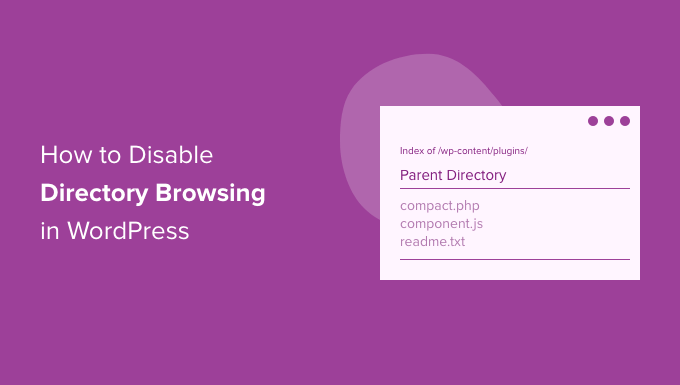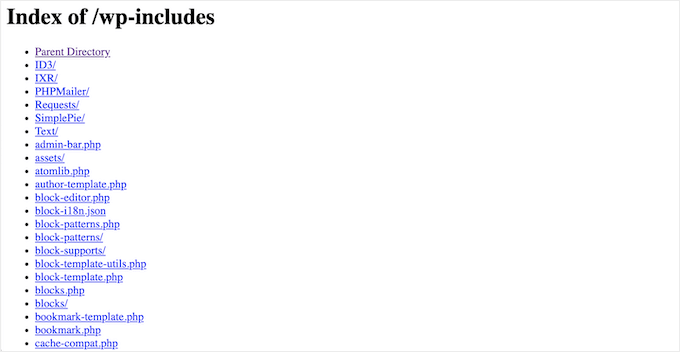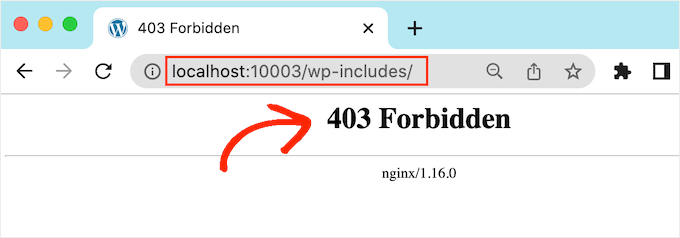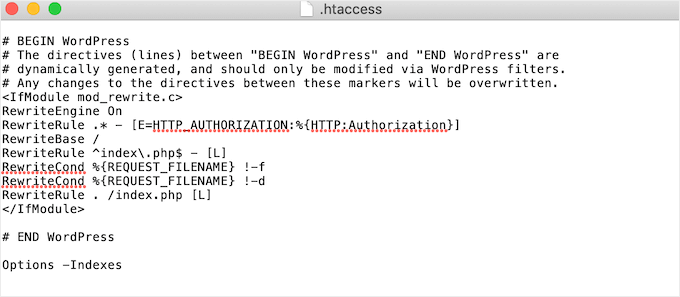We have seen many websites that don’t disable directory browsing. Unfortunately, this tiny mistake can expose sensitive information to hackers and may harm a website.
Directory browsing allows others to see your site’s files and folders. Hackers can then use this information to find vulnerabilities in plugins, themes, or your hosting server.
Taking this simple step can significantly improve your site’s security. It’s a quick fix that every website owner should know.
In this guide, we will show you how to disable directory browsing in WordPress. This will help you protect your site and keep your data safe.

What Does Disabling Directory Browsing in WordPress Do?
When a visitor accesses a website, the web server processes their request. Typically, the server delivers an index file, such as index.html, to their browser.
If an index file is missing, the server may display a list of all files and folders in that directory. This behavior, known as directory browsing, is commonly enabled by default on hosting servers.
We have seen first-hand how directory browsing can expose sensitive information about a site’s structure. This information could be used to identify vulnerabilities in plugins, themes, or even hosting setups.
Visitors might come across directory browsing when they see a plain list of files and folders instead of a webpage. This unintended access can lead to security risks if not addressed.

Hackers often exploit directory browsing to view a site’s files, including themes and plugins. If any of these have known vulnerabilities, attackers can use that information to compromise the website.
In many cases, directory browsing can also expose private or paid content, such as ebook downloads or online courses. This can lead to unauthorized copying and revenue loss.
Disabling directory browsing is a simple yet effective way to prevent these risks. It’s one of the first steps we recommend for securing a WordPress site.
How to Check if Directory Browsing Is Enabled in WordPress
An easy way to check if directory browsing is enabled on your WordPress website is by visiting the /wp-includes/ folder directly.
For example, just enter a URL like this: https://example.com/wp-includes/ in your browser.
Make sure to replace example.com with your actual website’s domain name. This simple test works across most WordPress installations.
If you see a 403 Forbidden message or a similar error, then directory browsing is already disabled. This is a good sign as it means your website is more secure.

If a list of files and folders appears instead, then directory browsing is enabled.
This is something that leaves websites vulnerable to malicious attacks.

In our experience, enabling directory browsing exposes sensitive information and increases security risks. For this reason, it’s best to disable directory browsing in WordPress to keep your site safe.
How to Disable Directory Browsing in WordPress
To disable directory listing, you’ll need to add some code to your site’s .htaccess file.
To access the file, you’ll need an FTP client, or you can use the file manager app inside your WordPress hosting control panel.
If this is your first time using FTP, then you can see our complete guide on how to connect to your site using FTP.
After connecting to your site, simply open your website’s public folder and find the .htaccess file. You can then edit the .htaccess file by downloading it to your desktop and then opening it in a text editor like Notepad.
At the very bottom of the file, simply add the following code:
Options -Indexes
It will look something like this:

Once you’re done, save your .htaccess file and upload it back to your server using an FTP client.
That’s it. Now, if you visit the same http://example.com/wp-includes/ URL, you’ll get a 403 Forbidden or similar message.

Expert Tip: If you suspect your WordPress website may have been hacked, then see our guide on fixing a hacked WordPress website. Alternatively, you choose our professional hacked WordPress site repair service and hire professional WordPress security experts to clean your website straight away.
Additional Reading:
Want to keep your WordPress website secure and error-free? You may find the following articles useful:
- Beginner’s Guide to WordPress File and Directory Structure
- Most Common WordPress Errors and How to Fix Them
- How to Fix File and Folder Permissions Error in WordPress
- How to Password Protect Your WordPress Admin (wp-admin) Directory
We hope this article helped you learn how to disable directory browsing in WordPress. You may also want to see our ultimate WordPress security guide or see our expert pick of the best WordPress security plugins.
If you liked this article, then please subscribe to our YouTube Channel for WordPress video tutorials. You can also find us on Twitter and Facebook.





Dennis Muthomi
I noticed that I have directory browsing disabled on my WordPress site, because I got a 403 error when trying to access wp-includes, yet I don’t remember ever having edited my .htaccess file to do so.
Does WordPress automatically disable directory browsing during initial installation?
WPBeginner Support
Unless there was a recent change it does not by default, it may be your hosting provider’s default settings for htaccess.
Admin
Dennis Muthomi
That’s what I was suspecting also, thanks for clarifying that WordPress doesn’t disable directory browsing by default.
And the respond too
Dayo Olobayo
I didn’t even know that this vulnerability existed. Just checked mine and got the 403 error. which means directory browsing is disabled. Thank you.
WPBeginner Support
You’re welcome
Admin
Jiří Vaněk
Thanks for the advice. On directory browsing, or that I have it enabled, the AIO SEO plugin keeps warning me. I have currently solved the problem by making the folders have an index file that is empty. Is it possible to take this as one of the possible solutions?
WPBeginner Support
You can try that method but we would still recommend the htaccess method from our guide.
Admin
Jiří Vaněk
Thanks for the advice, I finally used the Options -Indexes method now and AIO SEO already reports the problem as solved. Thanks again.
Ka Khaliq
After editing the htaccess file as per the provided guidelines, I do see 403 Forbidden message for /wp-includes/. But I’m unable to see edit any post. Upon editing a post, I see the same 403 Forbidden message. How to solve this?
WPBeginner Support
There may be an issue with your file permissions, we would recommend taking a look at our guide below for fixing your permissions:
https://www.wpbeginner.com/wp-tutorials/how-to-fix-the-403-forbidden-error-in-wordpress/
Admin
Ka Khaliq
The issue resolved after clearing the web history/cache.
Thanks for your time.
Dina D
Thank you so much! Clear, concise, and easy to follow. Thank you so much!
WPBeginner Support
You’re welcome!
Admin
Rabee Khan
Thank You… precise and easy to understand!
WPBeginner Support
Glad our guide was helpful!
Admin
Kimmy
Thanks for the two-word solution! Lol. Worked perfectly!
WPBeginner Support
Glad we could help!
Admin
Seashell
I was shocked to see the folders accessible right in the browser.
Thanks for your solution!
WPBeginner Support
Glad we could help!
Admin
Deepak Kumar
Its work like charm. Article on wpbeginners like ready to go solution. Keep it up.
Ayo
How do I now solve the 404 error that comes after?
Pradip Singh
I am in love with this website. Every day I am surprised when I read a new article from this website. Thankfully I read this article today and immediately I implemented the advice.
WPBeginner Support
Glad you found our content helpful
Admin
Sourabh
Will it block CDNs from accessing my website for static content?
WPBeginner Support
No, it will not.
Admin
sami
Does this method affect google crawling .. is it SEO friendly?
WPBeginner Support
It should not affect search engines crawling your site.
Admin
Meera Shaikh
Thanks its Done
WPBeginner Support
You’re welcome
Admin
Pradeep
Thanks my friend, I just try this and it’s work.
You are the genius.
WPBeginner Support
Glad our guide was helpful
Admin
mousam
Thank you. I applied and it worked.
You guys are the best source for learning wordpress.
WPBeginner Support
You’re welcome, glad our guide was helpful
Admin
Kevine
Thank you very much for this. It solved my problem.
Thanks again.
WPBeginner Support
You’re welcome, glad our guide was helpful
Admin
malika
Thank you for sharing information!
WPBeginner Support
You’re welcome
Admin
Jonthan
So is it ok to have this code on .htaccess file even when an index.php file is present in the root folder.
Kindly respond.
WPBeginner Support
Yes
Admin
Teresa Cuervo
Do you need Filezila to do this or can you go to the FTP via Cpanel and do this?
Thank you
WPBeginner Support
You can use either, not all hosts have a file manager is why we show Filezilla
Admin
michael
Hello
does this action affect pages indexing on search engines?
and does it make some problems for indexed pages of my WordPress website?
Thanks
WPBeginner Support
No, it would not affect that negatively.
Admin
Rhen Castrodes
Thank you. it works
WPBeginner Support
Glad our recommendation was able to help you
Admin
John
Thank you! It works even now in 2020.
WPBeginner Support
You’re welcome
Admin
Shams
Amazing post,
Just have simple question, I added this code and it’s working, the question is Google indexes those page e.g sitecom/wp-contents/2019/2, will Google remove those pages automatically now as these are 404. Or I should remove it in Search Console?
Thanks
WPBeginner Support
This code should not make your direct links to images and files turn into 404s
Admin
Bill
Hello!
I recently applied this rule
and at the same day the front page of my blog
got vanished from google index.
Do you see any connection?
WPBeginner Support
Adding this to your htaccess should not affect your indexing, there are multiple reasons and you would want to check your Google Search Console for what it says about your home page.
Admin
Ionel G
Thanks for all the tips that you provide!
I am still wondering how can you hide the wp-content & wp-include folder from sources? I hate it when someone goes right click and source it can see all of my plugins :). Do you have any script for this?
Thank you in advance!
WPBeginner Support
We do not have a recommended method for that at the moment, the most common reason you can’t see those folders in dev tools is a site’s cache.
Admin
Mayur
Could you please tell me How can i disable WordPress in sub folder like my WordPress install on [www.mydomain.com] and i want to disable wordpress in [www.mydomain.com/customscript]
WPBeginner Support
You may want to first take a look at creating a custom page template: https://www.wpbeginner.com/wp-themes/how-to-create-a-custom-page-in-wordpress/
Otherwise, you would need to create a folder with that name and inside that folder add an index.html file for a nonWordPress page to appear.
Admin
Rafael
Thank you. Worked perfectly for all browsers.
Dipankar
but wp-content is showing . how to remove it as well.
Deatram
I disabled directory browsing, but still someone can see my directory when they use developer tools in chrome browser. How do I disable in that as well?
Faeze
I added the line that you said in .htaccess but it showes my directories yet .
What should I do now??
Nathan
When I click “Save Changes” on the Permalink Settings page the .htaccess file is updated, erasing the “Options -Indexes” code that I inputted. The code works fine, but I am concerned I will unknowingly delete it while performing some other task. Are there any other dashboard settings changes that I should know about that may affect the .htaccess file and erase the code? Thanks
Tôi Sống
Awesome, it work very good!
Baggio
Huge fan of wpbeginner, Optin Monster – I got so many useful tips and tricks on WP – and I have to say, the site design is just brilliant. And of course, the content here is epicly useful.
Thanks guys!
daniel
Hey! It doesnt seem to work. if i pull an image to another page its opened with a link of: example.com/wp-content/uploads/…
Any idea? thanks!
WPBeginner Support
Hey Daniel,
Your images and files inside directories can still be directly accessed. However, server will not let someone directly browse a directory and see its contents.
Admin
Axel Jebens
I would appreciate if you could iterate on this. I had a hard time when trying to get a solution for this issue. There are some ideas based on a htaccess redirecting to a php file that first checks if the user is logged on. Is there any plugin which provides such a function?
Ünal Hoca
Thank you
Khalid Mahmud
Thank you. It’s working…….
Kim
Sorry to late ask. I want to know, are these techniques safe to use regarding SEO score ? Hope you answer !
WPBeginner Support
Yes, they are.
Admin
Kimmy
Still works pretty well. Awesome, simple, and working. Thanks!
Charles
I have been writing this same code for weeks now but my directory remains visible to users. Pls what am doing wrong? Or could it be that my site is still loading from cached contents? Everybody says it is working but my own experience is different. Any help will be appreciated! Thanks in anticipation of your reply.
Kimmy
What part are you having trouble on? What is your hosting provider btw?
Lily
Thank you. Worked like a charm!
Prakash
This Above Trick Is Not Working Man….
Mike
Is there a way to allow viewing a directory but just hide the Parent Directory link for a specific page? This would be a network share folder that multiple people would access, and have sub folders which would still require a parent directory listing. I just don’t want anyone going above the shared folder.
Christian Nastari
This didn’t work for me. I tried before and after #END WordPress and didn’t work. I also tried “Options All -Indexes”, but didn’t work either
hrwhisper
very helpful, thank you very much
nitai
Really great. today I just faced and thinking how can I disallow like joomla and I found the exact solution.
Rob Myrick
This was very helpful and quick – thank you
Anita in SD
Thanks so much, was dismayed to see images from my site going to a parent directory :0. This was very helpful and worked well.
Blessings – A
Heather Jacobsen
Thanks for this tutorial. It worked great for hiding my uploads from anyone just wanting to browse that directory. One question, though. Does this by chance turn off the ability of search engines to browse my website. Sorry if it seems like a dumb question. I am a newbie, after all.
Wasil Burki
I added the Options -Indexes code to the htaccess file, however now I am not able to access the site I get a 503 error. Am I doing something wrong? Need help bad!! Thanks